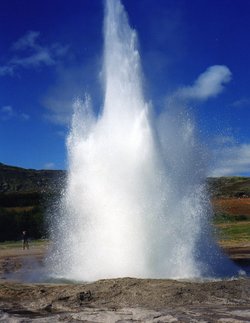Geysir
|
|

Geysir (sometimes known as The Great Geysir), in the Haukadalur valley, Iceland, is the oldest known geyser and one of the world's most impressive examples of the phenomenon. The English word geyser to describe a spouting hot spring derives from Geysir (which itself is derived from the Icelandic verb gjósa meaning to erupt. The English verb gush is probably related to that word). Geysir lies on the slopes of Laugarfjall hill which is also the home to Strokkur geyser.
Eruptions at Geysir can hurl boiling water up to 60 metres in the air. However, eruptions may be infrequent, and have in the past stopped altogether for years at a time. Currently, eruptions are occurring about three times a day on average.
| Contents |
History of Geysir
The oldest accounts of a geyser at Haukadalur date back to 1294. Earthquakes in the area caused significant changes in local neighbouring landscape creating several new hot springs. Changes in the activity of the Geysir and the surround geysers are strongly related to earthquake activity. In records dated 1630 the geysers erupted so violently that the valley around them trembled.
In recent times earthquakes have tended to revive the activity of Geysir which then subsides again in the following years. Before 1896 Geysir was almost dormant before an earthquake that year caused eruptions to begin again, occurring several times a day, lasting up to an hour and causing spouts of up to 60 metres in height. By 1935 the geyser was almost dormant again and a manmade channel was dug through the silica rim around the edge of the geyser vent. This ditch caused a lowering of the watertable and a revival in activity. Gradually this channel too clogged with silica and eruptions again became rare. In 1981 the ditch was cleared again and eruptions could be stimulated, on special occasions, by the addition of soap. Following environmental concerns the practice of adding soap was seldom employed during the 1990s. During that time Geysir seldom erupted. When it did erupt, it was spectacular, sending boiling water about forty metres into the air. On the Icelandic National Day authorized government geologists would force an eruption. A further earthquake in 2000 revived the geyser again. Initially eruptions were taking place on average eight times a day. By July 2003 this activity had again decreased to around three times per day.
The nearby geyser Strokkur erupts much more frequently than Geysir, erupting to heights of up to 20 metres every five minutes or so. Strokkur's activity has also been affected by earthquakes, although to a lesser extent than the Great Geysir. There are around thirty much smaller geysers and hot pools in the area, including one called Litli Geysir ('Little Geysir').
Litli_Geysir.jpg
Descriptions of the Great Geysir and Strokkur have been given in every travel guide to Iceland published from the 18th century onwards. Today the geyser remains an essential element of almost every tourist's itinerary. The place is, together with Ţingvellir and the Gullfoss waterfall, part of the most famous sights of Iceland, the Golden Circle.
Ownership of the Geysir area
Until 1894 the Geysir area was owned by a local farmer. In that year the area was sold to James Craig (later Lord Craigavon), a whisky distiller and future Prime Minister of Northern Ireland. Initially he erected large fences around the site and an entrance fee was charged for visitors wishing to view the geysers. The following year however Craig appeared to tire of his project and gave the area as a present to a friend, E. Craig, who dropped the entrance fees. Later Craig's nephew Hugh Rogers inherited the site. In 1935 he sold the site to film director Sigurđur Jónasson who subsequently donated it to the Icelandic people in perpetuity.
Geology and physics of Geysir's eruptions
Please see the geyser article for a general description.
See also
References
- The Great Geysir, Helgi Torfason of the Icelandic National Energy Authority, 1985. (No ISBN, but book available from the Geysir tourist center)
External links
- Photos: [1] (http://icelandiscool.com/geysir/)[2] (http://www.islandsmyndir.is/html_skjol/sudurland/geysir/forsida_geysir_1.htm)de:Strokkur fr:Haukadalur
